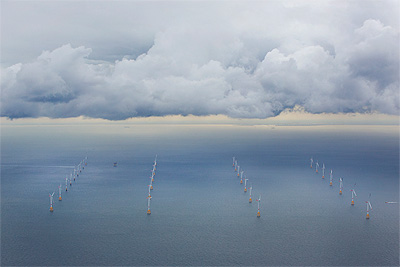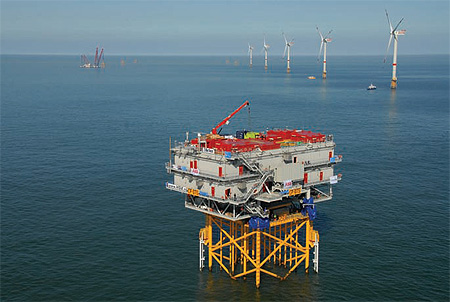
Thornton Bank: Pioneering Offshore Wind in Belgium
A sustainable mission
Backed by a strong consortium of both Belgian and international shareholders, C-Power NV was founded to develop and operate the first offshore wind farm within the Thornton Bank concession area in the North Sea. The company’s Belgian shareholders are comprosed of DEMA, S.R.I.W Environment, Socofe and Z-Kracht, with Nuhma NV acting as a reference shareholder. Additionally C-Power is further supported by RWE, EDF and Marguerite. This combination of industrial, financial and public shareholders represents a key strength in the development of the Thornton Bank wind farm. Indeed the shareholders provide deep industrial know-how in the energy sector in general and in the offshore wind sector in particular, a strong creditworthiness and wellestablished knowledge of the Belgian market.
The Thornton Bank wind farm is located around 30 km from the Belgian coastline at a water depth ranging from between 12 m and 27.5 m, encompassing a total area of 19.84 km2. The facility’s total capacity is 325.2 MW allowing for an annual power generation of 1050 GWh. As the first offshore wind project to be developed in the Belgian North Sea, the Belgian authorities required C-Power to start the Thornton Bank project with a pilot phase in order to prove the viability and innovate the concept. This pilot phase would become the first of three construction phases leading to the completion of the project. Construction of Phase 1 of the Thornton Bank wind farm began on May 13th 2007, with the construction of the wind turbines and connection of the turbines to the power grid commencing in 2008. Phase 1 of the project consists of six 5M Senvion turbines in a single row. The turbines themselves are built on gravity-based foundations and are connected together by 33 kV cables. They are then linked to the onshore high voltage station via a 150 kV export cable. The final turbine in the first-phase deployment went into operation on May 10th 2009.
Following the successful implementation of the trial phase of the Thornton Bank wind farm, approval was granted for the development of phases 2 and 3 with construction commencing on November 25th 2010 and finishing during July 2013. Phase 2 and 3 consists of 48 6M Senvion turbines, with 24 turbines being deployed in each sub area. Furthermore in installation includes an offshore power station (OTS) as well as a second 150 kV export cable. The wind turbines in phases 2 and 3 are built on jacket foundations and are connected together and to the OTS via 33 kV cables. The turbines were provided by Senvion, which is also the company responsible for the operation and maintenance of the wind turbines during the first ten years of exploitation with the possible extension of a further ten years. The installation of the turbines was undertaken by the THV Seawind consortium (Deme & Fabricom), which was also in charge of balancing plants works including onshore works, construction and installation of foundations and the installation of cables. All of the cables used as well as the offshore transformer platform (OTS) were designed and supplied by ABB.
By September 2013 Thornton Bank reached its full capacity, allowing it to provide energy to 600,000 inhabitants each year. Commenting on the project CEO Jaak Rutten said: “It is a project to be really proud of, carried out with tremendous enthusiasm and skill, at times achieving innovative solutions, accomplished by breaking new ground and staying the course. It is a feather in the cap of our workers and partners, who pulled off a difficult feat without incident to speak of, on time and within budget.”
Key to the development of the Thornton Bank wind farm is the part it will play in enabling the reduction of CO2 emissions. Through the continued operation of the site, C-Power makes a very valuable contribution to both the European and Belgian environmental objectives concerning renewable energy and the reduction of the CO2 emission. C-Power contributes seven per cent of the renewable energy capacity needed for Belgium to meet its 2020 objective. Compared to the environmental impact of traditional energy sources, the environmental impact of wind power is very positive. Wind power consumes no fuel and emits no air pollution, neither does it generate any toxic waste nor does it constitute a major safety risk. Furthermore the energy consumed in the manufacture and transport of the materials used in the construction of wind facilities is equal to the new energy produced by the plant within only a few months. Through an expected yearly production of 1TWh, C-Power will avoid the release of 415,000 tonnes of CO2, which represents the annual CO2 absorption of a forested area of 65,000 and one third of the forest region within the Flemish region. “With our 325,2 MW offshore wind farm, we contribute to delivering a cleaner and safer environment to our children and grandchildren,” Jaak says.
C-Power NV
Services: Offshore wind farm development and management